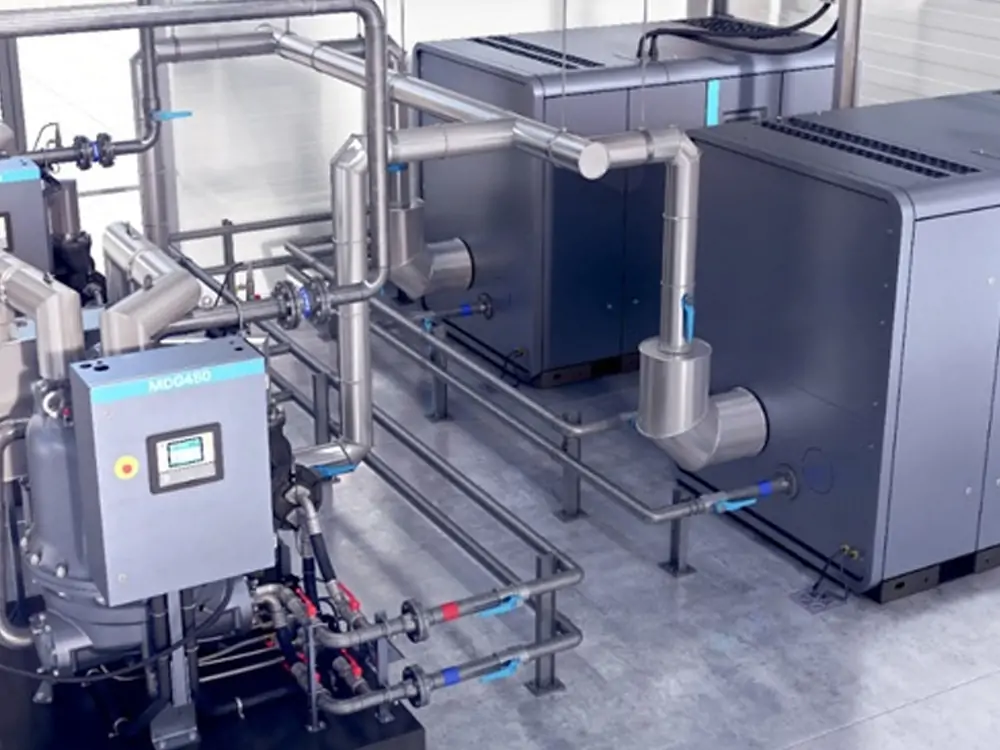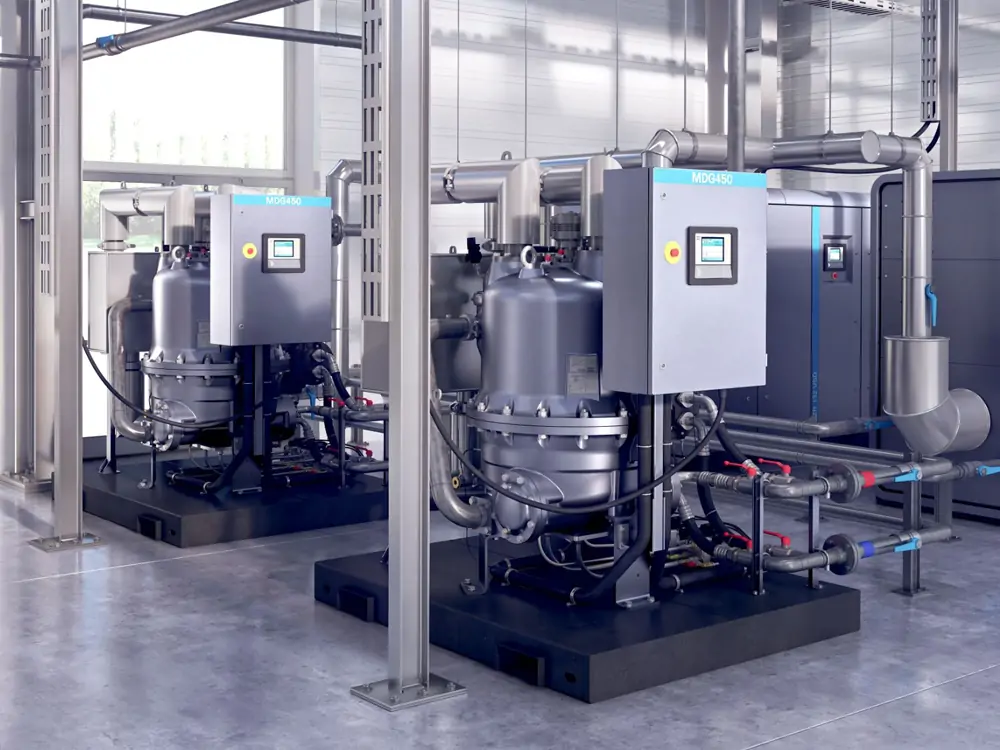L'essiccatore con compressore d'aria è un elemento essenziale dei sistemi ad aria compressa. Inevitabilmente, ci sarà umidità durante il funzionamento del compressore d'aria. It can contaminate the end product and damage our production equipment and components. This is why it must remove this moisture in the compressor system. Compressed air dryers are the devices that help dry the wet air. Questo garantisce la qualità della vostra aria compressa. Ma a te, what is the best air dryer for air compressors? E come selezionarli?
Whether you are an engineer, technician, or manufacturer, this article will provide in-depth insights and guidance on this critical topic. Let’s choose the right drying solution for your air compression system.
How Do You Select The Air Dryer For Air Compressor
It must know the following parameters to choose the right compressed air dryer. Let’s talk about it.
Air Capacity
The air compressor dryer can handle this maximum flow of compressed air. In primo luogo, the user needs to determine this value based on the consumption of all air-consuming equipment and the usage factor. Ovviamente, se hai già un compressore d'aria, you can send the nameplate to the manufacturer.
As a professional air compressor dryer manufacturer, ve lo diciamo responsabilmente. Se usi molta aria, choose a compressed air dryer with a larger capacity. Questo è, la portata d'aria dell'essiccatore dovrebbe essere maggiore di quella del compressore d'aria. Perché in tempi di alta temperatura e umidità, il contenuto d'acqua dell'aria aumenta. In questo momento, the dryer machine is overloaded. COSÌ, the drying effect will decrease. Questo può causare molti problemi, come grandi quantità di umidità e guasti alle apparecchiature.
Inlet Air Pressure
Different air pressures and different air capacities of the dryer. Le pressioni comuni nella produzione industriale vanno da 0,6 MPa a 1,0 MPa. COSÌ, the most common is the normal pressure air compressor air dryer.
Tuttavia, altri settori hanno requisiti di pressione diversi. Per esempio, l'industria del laser generalmente richiede 16 bars. Some industries require high-pressure compressed air dryers. La nostra azienda è in grado di personalizzare asciugatrici fino a 100 sbarra.
Inlet Air Temperature And Ambient Temperature
La temperatura è fondamentale per la scelta dell'essiccatore con compressore d'aria. Per esempio, ci sono due tipi di essiccatori d'aria a refrigerazione. Namely normal temperature (50°C) and high temperature (80°C). The temperature is very high in Pakistan and the Middle East in summer. First, it must choose a high-temperature type of refrigerant dryer. Inoltre, spesso abbiamo bisogno di scegliere un modello più grande. This not only achieves good water removal but also avoids dryer downtime.
D'altra parte, la temperatura dell'aria in ingresso dell'essiccatore ad adsorbimento non dovrebbe generalmente essere superiore a 40°C. If the temperature is too high, l'effetto di rimozione dell'acqua dell'adsorbente sarà notevolmente ridotto. Ovviamente, it can choose the HOC type desiccant dryer now.
Dew Point Requirement of Air Compressor Dryer
Different dew point requirements and different equipment configurations. Naturalmente, the price is different. Gli essiccatori a ciclo frigorifero hanno generalmente un punto di rugiada in pressione di 2 a 10°C. There are different conditions and different dew points. Per esempio, refrigerant compressed air dryers can achieve a very low dew point. Ma richiede una condizione operativa standard di 25°C e 7 sbarra.
Diversi settori hanno requisiti diversi per i punti di rugiada. I seguenti sono alcuni esempi.
- Industria farmaceutica: il punto di rugiada è di almeno -40°C.
- Industria dei circuiti stampati: il punto di rugiada deve raggiungere i -20°C.
- Industria della separazione gas-aria: il punto di rugiada deve essere -70°C.
Choose a combination dryer if you require a dew point of -70°C. Oppure ci devono essere un essiccatore a refrigerazione e filtri prima dell'essiccatore ad adsorbimento.
Voltage And Frequency
Varia da paese a paese. Per esempio, nel Nord America, 220V/60HZ/monofase e 380V/60HZ/trifase sono comuni. In questo momento, ha bisogno di personalizzare il compressore del refrigerante. A volte anche il prezzo del tintore sarà diverso.
Raw Materials
Some industries have requirements for the material of air compressor dryers. Per esempio, the pharmaceutical industry requires stainless steel. In questo caso, le tubazioni e il sistema di scambio termico devono essere SS304. E anche la torre di adsorbimento necessita di SS304. Inoltre, l'industria delle batterie al litio richiede anche l'acciaio inossidabile.
L'essiccatore in acciaio inossidabile sarà più costoso. Ovviamente, you can choose the Lingyu PD series refrigerated air dryer. You can also choose the modular desiccant compressed air dryer. Possono anche soddisfare i requisiti delle industrie alimentari e farmaceutiche.
Environmental Requirements
Il refrigerante abituale degli essiccatori d'aria a refrigerazione è R22. È comune nei paesi in via di sviluppo. Tuttavia, I paesi europei e americani richiedono refrigeranti ecologici. Per noi, R134a, R407C, R410a sono disponibili. The dryer is a little more expensive if you want an eco-friendly refrigerant.
Air Cooled vs. Water Cooled Refrigerated Compressor Air Dryer
L'essiccatore d'aria a refrigerante a flusso ridotto è raffreddato ad aria. Il nostro essiccatore raffreddato ad aria può essere fino a 120 m³/min. Se sopra 120 m³/min, the air compressor air dryer is water-cooled.
For high-flow dryers, the size will be very large if you need an air-cooled type. Per esempio, sarà alto più piani. E l'efficienza dello scambio termico sarà molto peggiore. The water-cooled dryer is not affected by a high-temperature environment. Ovviamente, there needs to be a cooling water system. Quindi questo aggiungerà dei costi.
Energy Saving Requirements
① Fixed vs. Variable Frequency Refrigerated Air Dryer
We commonly use fixed-frequency air compressor dryers. Può soddisfare la massima potenza. Tuttavia, in actual production activities, la richiesta d'aria varia. A piccole richieste, funziona ancora alla massima potenza. Ciò comporta uno spreco di energia. Anzi, the output of the variable frequency dryer can match the air demand. Ciò si traduce in un notevole risparmio energetico e sui costi operativi.
② Choice of Desiccant Dryer Regeneration Method
The heatless compressed air dryer has a small power of ~0.1 kW. But it has a big air consumption of about 15%. Questo è un elevato consumo di energia. L'essiccatore ad adsorbimento microriscaldato generalmente consuma circa 8% dell'aria di rigenerazione. Rispetto all'essiccatore senza calore, può salvare 40% di energia.
L'essiccatore ad adsorbimento a perdita d'aria zero consuma 0% aria di rigenerazione. A heatless air compressor air dryer can save 70% di energia. Ovviamente, it is more expensive.

How to Size The Air Dryer For Air Compressor?
Sizing an air dryer for air compressor involves determining the appropriate capacity and specifications of the dryer. So it can remove moisture and contaminants from the compressed air effectively. The sizing process ensures that the air dryer can handle the air volume and achieve the desired dew point, maintaining the compressed air quality.
Here are the steps to size an air compressor air dryer.
Determine Compressed Air Flow Rate (CFM)
Measure or calculate the maximum compressed air flow rate that your air compressor system requires. This is usually expressed in cubic feet per minute (CFM). It is a crucial parameter for sizing the air dryer.
Calculate Inlet Air Temperature And Pressure
Determine the temperature and pressure of the compressed air at the dryer’s inlet. This information is necessary to calculate the corrected flow rate and dew point.
Consider Ambient Conditions
Account for variations in ambient temperature and humidity, as these can affect the performance of the air dryer. Understanding the environmental conditions helps in selecting the appropriate dryer type and specifications.
Determine Required Dew Point
Define the desired dew point or moisture level for your application. The dew point is the temperature at which air becomes saturated with moisture and starts to condense. Choosing a dew point suitable for the application is crucial to prevent potential issues.
Select The Right Type of Compressed Air Dryer
Choose the appropriate type of air dryer based on the required dew point and application. Common types include refrigerated dryers, desiccant dryers, and membrane dryers. Each type has specific advantages and is suitable for different dew point requirements.
Calculate The Corrected Flow Rate
Adjust the compressed air flow rate for the actual conditions using the information gathered earlier. Correcting for temperature and pressure ensures that the air dryer is sized accurately.
Consult Manufacturer Specifications
Refer to the manufacturer’s specifications and performance data for the selected air dryer type. So it can verify that it can handle the corrected flow rate and achieve the desired dew point.
Account For Safety Factors
Consider adding a safety factor to ensure the air dryer can handle variations in air demand and operating conditions, providing a buffer for unexpected fluctuations.
Choose The Appropriate Air Dryer Size
Based on the corrected flow rate, dew point requirements, safety factors, and manufacturer specifications, select the suitable size and model of the air dryer that meets the system’s needs.
Installation And Monitoring
Install the chosen air dryer correctly within the compressed air system. Regularly monitor its performance and maintain it according to the manufacturer’s recommendations to ensure optimal efficiency and reliability.

Conclusione
In modern industry, compressed air dryers are an indispensable tool. They provide continuous and stable high-pressure air for a variety of applications. Tuttavia, to ensure reliable operation and extend the compressor’s life, air quality management becomes critical. Selecting and sizing the right compressor air dryer is one of the important steps in ensuring good operation.
By following these steps and considering the specific requirements of your air compressor dryer system, you can accurately size an air dryer to maintain the desired air quality and enhance the overall efficiency of the compressed air dryer system.
